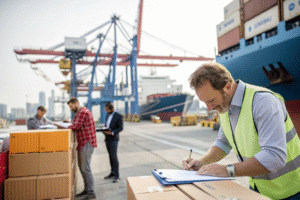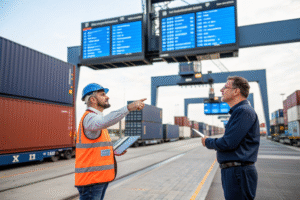Shipping from China to the U.S. can feel like guessing a moving target. Prices shift daily, and it’s easy to feel lost. I’ve been there — wondering if I’m overpaying or missing something critical.
Ocean freight costs from China to the USA vary widely depending on season, cargo size, and route. In 2025, a standard 40-foot container costs between $3,200 and $4,800 on average.
Whether you're a new importer or a seasoned buyer like Ron, understanding how freight rates work — and how to reduce them — can make a big difference in your margins. Let’s break it down clearly and simply.
Average container shipping rates in 2025
Ocean freight rates shift fast. Sometimes they rise overnight due to global events or local port congestion. Sometimes they drop just as suddenly. What’s happening this year?
In 2025, the average shipping rate for a 20-foot container from China to U.S. West Coast is around $2,000–$2,600. For a 40-foot container, rates range from $3,200 to $4,800. East Coast routes cost 20–30% more.

What are the current benchmark prices for major ports?
Below is a breakdown of estimated average FCL (Full Container Load) ocean freight rates as of mid-2025:
| Route | 20GP Rate (USD) | 40GP Rate (USD) |
|---|---|---|
| Shanghai → Los Angeles | $2,100 | $3,400 |
| Ningbo → Long Beach | $2,200 | $3,500 |
| Shenzhen → Oakland | $2,000 | $3,200 |
| Qingdao → New York | $2,800 | $4,600 |
| Xiamen → Savannah | $2,750 | $4,500 |
These are port-to-port rates. They don’t include local charges, customs clearance, or delivery to your warehouse. That’s why a complete cost quote from a freight forwarder like GeeseCargo always includes “all-in” pricing.
Why do rates fluctuate so much even for the same route?
Several variables push ocean freight rates up or down. In 2025, some of the key influencers include:
- Increased global demand after post-COVID recovery
- Labor disputes at U.S. ports, especially Long Beach
- Shipping line alliances adjusting capacity
- Changes in fuel prices and surcharges
When I talk with our partners at major ports, they tell me that more automation is helping stabilize costs — but only slightly. At the end of the day, supply and demand still rule ocean freight.
Key factors that affect ocean freight pricing
Not all containers are priced the same. Two importers could ship the same size box but pay very different rates. Why? Because pricing depends on more than just dimensions.
Ocean freight rates are shaped by multiple factors including distance, volume, season, port congestion, and special cargo requirements. Understanding these helps you plan better and avoid surprises.

What are the main elements that drive up freight costs?
Let’s go through the most important pricing factors one by one:
| Factor | Impact on Cost |
|---|---|
| Distance to destination port | Longer routes cost more |
| Container type | Special equipment like reefer or open-top costs more |
| Peak vs. off-peak season | Peak times (Aug–Nov) see surcharges |
| Carrier selection | Some carriers charge more for faster, premium services |
| Port congestion or strikes | May lead to longer transit times and higher demurrage |
| Fuel costs (BAF) | Bunker Adjustment Factors vary monthly |
| Currency exchange rate | Impacts fuel and surcharge calculations |
In one shipment from Qingdao to New Jersey last year, my client paid an extra $500 because of a sudden chassis shortage. These hidden costs are avoidable if you work with the right forwarder.
Are there hidden fees or common pricing traps?
Yes. Here are common charges importers often miss:
- ISPS Fees (Security)
- Documentation Fees
- Destination Handling Charges (DTHC)
- Customs Exam Fees (if cargo is selected for inspection)
I always recommend asking for a door-to-door all-in quote. That’s how we quote at GeeseCargo — so you know the real cost, not just the shipping rate.
How to calculate full container load (FCL) cost
Knowing your container rate is only half the story. You also need to understand how to calculate the true total — including everything from origin to destination.
To calculate FCL cost, you need to add up base ocean rate, origin charges, destination fees, customs, and final delivery. An all-in FCL shipment to the U.S. can range from $4,500 to $7,000 per 40-foot container.

What components are included in a full ocean freight invoice?
Here’s a typical breakdown of an FCL shipment cost:
| Charge Type | Description | Estimated Range (USD) |
|---|---|---|
| Base Ocean Freight | Port-to-port rate | $3,400–$4,800 |
| Origin Charges | Pickup, port handling, export docs | $300–$500 |
| Destination Charges | Port handling, DTHC, delivery | $500–$800 |
| Customs Clearance | Import documentation and broker fees | $100–$300 |
| Delivery to Warehouse | Inland trucking in the U.S. | $500–$1,000 |
So, if Ron is shipping apparel from Guangzhou to a California warehouse, his all-in FCL quote might look like:
- Base rate: $3,600
- Origin fee: $400
- Destination fee: $650
- Customs: $200
- Trucking: $600
Total: $5,450
How can forwarders help you budget more accurately?
At GeeseCargo, we don’t just give you a number. We give you a roadmap. We break down the quote in plain English, flag possible risks, and even include alternatives.
For example, if your cargo isn’t time-sensitive, we might suggest a slower sailing that saves $500. If your product is high value, we’ll walk you through optional insurance add-ons.
Over the years, clients told me our quoting system helped them set better retail prices — because they could finally plan logistics costs upfront, not guess them later.
Tips to reduce ocean freight costs from China
Everyone wants to save on shipping — especially when margins are tight. Fortunately, there are smart ways to cut costs without risking delays or damage.
Reducing ocean freight costs is possible by planning early, consolidating shipments, choosing the right Incoterms, and working with a reliable freight forwarder who offers transparent, optimized routing.

What practical steps can help you lower your shipping bill?
Here are some tested strategies we use for clients:
| Tip | Description |
|---|---|
| Book in advance | Rates are cheaper 2–3 weeks before departure |
| Use off-peak season | Avoid shipping between August–November |
| Optimize container load | Maximize volume to reduce per-unit cost |
| Consolidate shipments | Combine orders from multiple suppliers |
| Choose FOB over EXW | Avoid extra origin charges by letting supplier handle delivery to port |
| Work with one forwarder | Loyalty often brings better rates |
In one case, we helped a client reduce annual shipping costs by 18% simply by changing their container stuffing method and avoiding LCL shipments when not necessary.
Should you choose FCL or LCL — and does it affect pricing?
This is a common decision point. LCL (Less than Container Load) may seem cheaper if you ship small quantities. But per cubic meter, it’s often more expensive.
Here’s a quick comparison:
| Factor | FCL (Full) | LCL (Partial) |
|---|---|---|
| Cost per CBM | Lower | Higher |
| Transit Time | Faster | Slower |
| Risk of Damage | Lower (less handling) | Higher (more touch points) |
| Paperwork | Simpler | More complex |
| Customs Issues | Easier to control | Risk of delay if others in same container are flagged |
Whenever possible, I recommend clients go FCL — even if they aren’t 100% full. We can help you consolidate with other suppliers or even suggest strategic inventory planning to justify a full box.
Conclusion
Ocean freight from China to the U.S. doesn't have to be confusing or overpriced. With the right knowledge — and the right partner — you can ship smarter, save money, and stay ahead of your competition.









